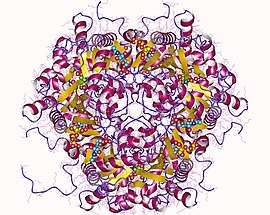Glucosamine-6-phosphate deaminase
In enzymology, a glucosamine-6-phosphate deaminase (EC 3.5.99.6) is an enzyme that catalyzes the chemical reaction
- D-glucosamine 6-phosphate + H2O D-fructose 6-phosphate + NH3
| glucosamine-6-phosphate deaminase | |||||||||
|---|---|---|---|---|---|---|---|---|---|
 Glucosamine-6-phosphate deaminase hexamer, Human | |||||||||
| Identifiers | |||||||||
| EC number | 3.5.99.6 | ||||||||
| CAS number | 9013-10-9 | ||||||||
| Databases | |||||||||
| IntEnz | IntEnz view | ||||||||
| BRENDA | BRENDA entry | ||||||||
| ExPASy | NiceZyme view | ||||||||
| KEGG | KEGG entry | ||||||||
| MetaCyc | metabolic pathway | ||||||||
| PRIAM | profile | ||||||||
| PDB structures | RCSB PDB PDBe PDBsum | ||||||||
| Gene Ontology | AmiGO / QuickGO | ||||||||
| |||||||||
Thus, the two substrates of this enzyme are glucosamine 6-phosphate and H2O, whereas its two products are fructose 6-phosphate and NH3.
This enzyme belongs to the family of hydrolases, those acting on carbon-nitrogen bonds other than peptide bonds, specifically in compounds that have not been otherwise categorized within EC number 3.5. The systematic name of this enzyme class is 2-amino-2-deoxy-D-glucose-6-phosphate aminohydrolase (ketol isomerizing). Other names in common use include glucosaminephosphate isomerase, glucosamine-6-phosphate isomerase, phosphoglucosaminisomerase, glucosamine phosphate deaminase, aminodeoxyglucosephosphate isomerase, and phosphoglucosamine isomerase. This enzyme participates in aminosugars metabolism. This enzyme has at least one effector, N-Acetyl-D-glucosamine 6-phosphate.
Structural studies
As of late 2007, 5 structures have been solved for this class of enzymes, with PDB accession codes 1J5X, 1JT9, 1NE7, 2BKV, and 2BKX.
References
- COMB DG, ROSEMAN S (1958). "Glucosamine metabolism. IV. Glucosamine-6-phosphate deaminase". J. Biol. Chem. 232 (2): 807–27. PMID 13549465.
- Pattabiraman TN, Bachhawat BK (1961). "Purification of glucosamine 6-phosphate deaminase from human brain". Biochim. Biophys. Acta. 54 (2): 273–283. doi:10.1016/0006-3002(61)90366-3. PMID 14484386.
- Wolfe JB, Britton BB, Nakada HI (1957). "Glucosamine degradation by Escherichia coli. III. Isolation and studies of "phosphoglucosaminisomerase"". Arch. Biochem. Biophys. 66 (2): 333–339. doi:10.1016/S0003-9861(57)80008-3.